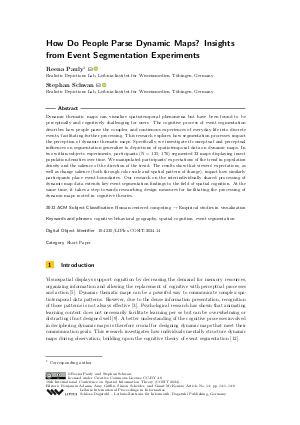How Do People Parse Dynamic Maps? Insights from Event Segmentation Experiments (Short Paper)
Authors
Reena Pauly  ,
Stephan Schwan
,
Stephan Schwan 
-
Part of:
Volume:
16th International Conference on Spatial Information Theory (COSIT 2024)
Part of: Series: Leibniz International Proceedings in Informatics (LIPIcs)
Part of: Conference: Conference on Spatial Information Theory (COSIT) - License:
 Creative Commons Attribution 4.0 International license
Creative Commons Attribution 4.0 International license
- Publication Date: 2024-09-09
File

PDF
LIPIcs.COSIT.2024.14.pdf
- Filesize: 0.69 MB
- 8 pages
Document Identifiers
Subject Classification
ACM Subject Classification
- Human-centered computing → Empirical studies in visualization
Keywords
- cognitive-behavioral geography
- spatial cognition
- event segmentation
Metrics
- Access Statistics
-
Total Accesses (updated on a weekly basis)
0PDF Downloads0Metadata Views
Abstract
Dynamic thematic maps can visualize spatiotemporal phenomena but have been found to be perceptually and cognitively challenging for users. The cognitive process of event segmentation describes how people parse the complex and continuous experiences of everyday life into discrete events, facilitating further processing. This research explores how segmentation processes impact the perception of dynamic thematic maps. Specifically, we investigate if conceptual and perceptual influences on segmentation generalize to depictions of spatiotemporal data on dynamic maps. In two within-subjects experiments, participants (N = 125, 176) segmented 32 maps displaying insect population densities over time. We manipulated participants’ expectations of the trend in population density and the salience of the direction of the trend. The results show that viewers' expectations, as well as change salience (both through color scale and spatial pattern of change), impact how similarly participants place event boundaries. Our research on the interindividually shared processing of dynamic map data extends key event segmentation findings to the field of spatial cognition. At the same time, it takes a step towards researching design measures for facilitating the processing of dynamic maps rooted in cognitive theories.
Cite As Get BibTex
Reena Pauly and Stephan Schwan. How Do People Parse Dynamic Maps? Insights from Event Segmentation Experiments (Short Paper). In 16th International Conference on Spatial Information Theory (COSIT 2024). Leibniz International Proceedings in Informatics (LIPIcs), Volume 315, pp. 14:1-14:8, Schloss Dagstuhl – Leibniz-Zentrum für Informatik (2024)
https://doi.org/10.4230/LIPIcs.COSIT.2024.14
BibTex
@InProceedings{pauly_et_al:LIPIcs.COSIT.2024.14,
author = {Pauly, Reena and Schwan, Stephan},
title = {{How Do People Parse Dynamic Maps? Insights from Event Segmentation Experiments}},
booktitle = {16th International Conference on Spatial Information Theory (COSIT 2024)},
pages = {14:1--14:8},
series = {Leibniz International Proceedings in Informatics (LIPIcs)},
ISBN = {978-3-95977-330-0},
ISSN = {1868-8969},
year = {2024},
volume = {315},
editor = {Adams, Benjamin and Griffin, Amy L. and Scheider, Simon and McKenzie, Grant},
publisher = {Schloss Dagstuhl -- Leibniz-Zentrum f{\"u}r Informatik},
address = {Dagstuhl, Germany},
URL = {https://drops.dagstuhl.de/entities/document/10.4230/LIPIcs.COSIT.2024.14},
URN = {urn:nbn:de:0030-drops-208297},
doi = {10.4230/LIPIcs.COSIT.2024.14},
annote = {Keywords: cognitive-behavioral geography, spatial cognition, event segmentation}
}
Author Details
References
- Douglas Bates, Martin Mächler, Ben Bolker, and Steve Walker. Fitting Linear Mixed-Effects Models Using lme4. Journal of Statistical Software, 67(1), 2015. URL: https://doi.org/10.18637/jss.v067.i01.
- Sarah E. Battersby and Kirk P. Goldsberry. Considerations in Design of Transition Behaviors for Dynamic Thematic Maps. Cartographic Perspectives, pages 16-32, March 2010. URL: https://doi.org/10.14714/CP65.127.
- Paweł Cybulski. An Empirical Study on the Effects of Temporal Trends in Spatial Patterns on Animated Choropleth Maps. ISPRS International Journal of Geo-Information, 11(5):273, April 2022. URL: https://doi.org/10.3390/ijgi11050273.
- Paweł Cybulski and Vassilios Krassanakis. The Role of the Magnitude of Change in Detecting Fixed Enumeration Units on Dynamic Choropleth Maps. The Cartographic Journal, 58(3):251-267, July 2021. URL: https://doi.org/10.1080/00087041.2020.1842146.
- Mary Hegarty. The Cognitive Science of Visual-Spatial Displays: Implications for Design. Topics in Cognitive Science, 3(3):446-474, July 2011. URL: https://doi.org/10.1111/j.1756-8765.2011.01150.x.
- John D. Hunter. Matplotlib: A 2D Graphics Environment. Computing in Science & Engineering, 9(3):90-95, 2007. URL: https://doi.org/10.1109/MCSE.2007.55.
- Christopher A. Kurby and Jeffrey M. Zacks. Segmentation in the perception and memory of events. Trends in Cognitive Sciences, 12(2):72-79, February 2008. URL: https://doi.org/10.1016/j.tics.2007.11.004.
- Frank Papenmeier, Annika E. Maurer, and Markus Huff. Linguistic Information in Auditory Dynamic Events Contributes to the Detection of Fine, Not Coarse Event Boundaries. Advances in Cognitive Psychology, 15(1):30-40, March 2019. URL: https://doi.org/10.5709/acp-0254-9.
- Barbara Tversky, Julie Bauer Morrison, and Mireille Betrancourt. Animation: can it facilitate? International Journal of Human-Computer Studies, 57(4):247-262, October 2002. URL: https://doi.org/10.1006/ijhc.2002.1017.
- Florian Wickelmaier. Simulating the Power of Statistical Tests: A Collection of R Examples, March 2022. arXiv:2110.09836 [stat]. URL: http://arxiv.org/abs/2110.09836.
- Jeffrey M. Zacks. Using movement and intentions to understand simple events. Cognitive Science, 28(6):979-1008, November 2004. URL: https://doi.org/10.1207/s15516709cog2806_5.
- Jeffrey M. Zacks. Event Perception and Memory. Annual Review of Psychology, 71(1):165-191, January 2020. URL: https://doi.org/10.1146/annurev-psych-010419-051101.
